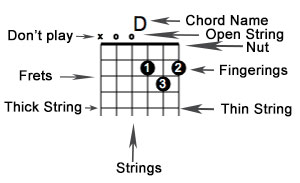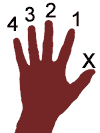Over the years musicians have devised a number of different ways to communicate their musical ideas. Even before the advent of the musical notation system we use today, musicians were recording their compositions for the lute in a form of tablature which survives to this day.
We will learn more about the tablature system in a later lesson but for now it is surfice to say that this ancient system represented the strings and frets of the lute and where to place the fingers. Chord diagrams are very similar to this system except they are used to represent a number of notes which are played together. A combination of two or more notes is called a chord.
The answer to this question depends on what you wish to get out of your guitar study. If you would like to be able to play in a number of musical genres and perhaps play in a band situation then the answer is yes. If your aim is to be able to accompany your own vocals then the ability to play from chord diagrams will be all you will need.
Don’t worry you need not make up your mind at this stage. Just follow the lessons in this section and after you have learnt your open chords and can play a load of cool songs you may decide to broaden your knowledge and start on learning standard notation. A knowledge of the Standard Notation System, which is a much more precise method of writing music, enables the player to learn more songs and material much faster.
The following illustration shows a chord chart and its basic elements.
Imagine that you are holding your guitar in front of you with the fret board facing toward you. The six vertical lines represent the six strings on a guitar.

Black dots on the diagram tell you what fret and string to place your fingers. Numbers inside the dots tell you which finger to use. When pressing down the string on to the fret wire only use the tips of your left hand fingers and make sure your finger pushes down as close to the front of the fret box as possible. This will ensure a clean ringing tone. If you are hearing a dull cluncky sound then examine where your finger is holding the string. Is it pushing the string down onto the fret? White dots mean to play the string open. An open string is a string that is played without any notes being fingered on the fret board.

The left hand fingerings are written inside the dots on the chord grid. As with all stringed instruments we do not count the thumb but start with the index as finger 1.
When fingering the notes make sure that your left hand fingers are curved and that you are using the tips of your finger pads. This will ensure you do not tough adjacent strings and stop them from vibrating. Above all listen critically to the sound that you are making. Strive for a clean sound without any fret/string buzz while at the same time use only the minimum of pressure to achieve a beautiful sound.
SHARE THIS PAGE!